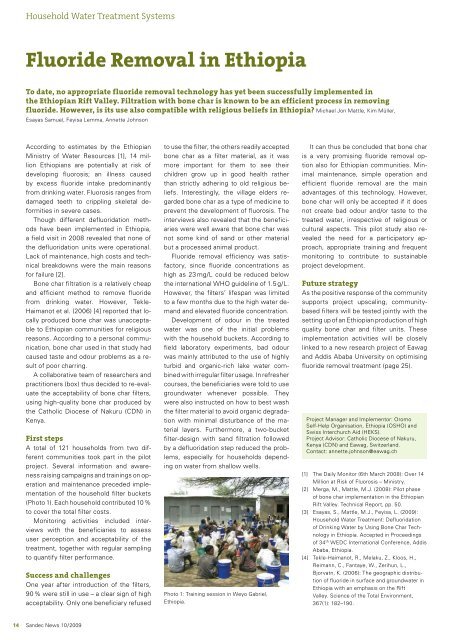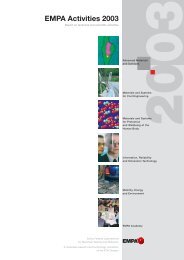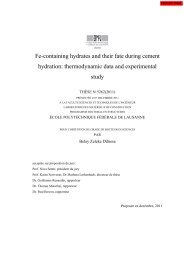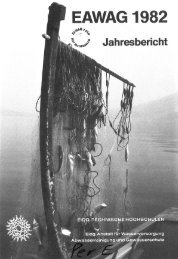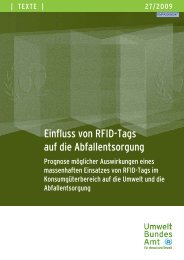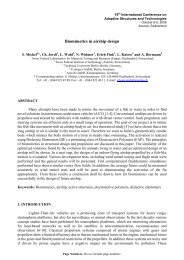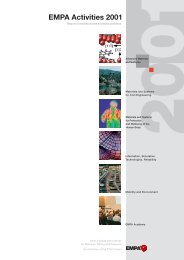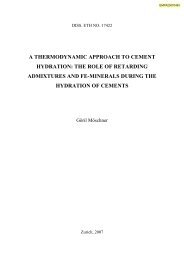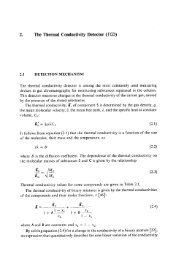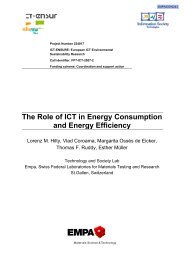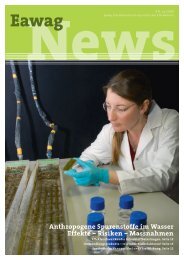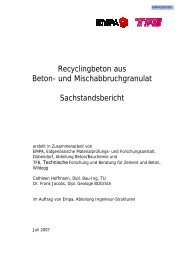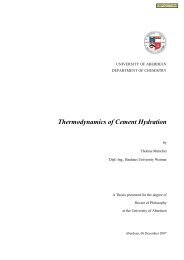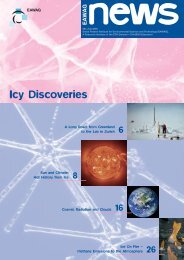Sandec - Eawag
Sandec - Eawag
Sandec - Eawag
You also want an ePaper? Increase the reach of your titles
YUMPU automatically turns print PDFs into web optimized ePapers that Google loves.
Household Water Treatment Systems<br />
Fluoride Removal in Ethiopia<br />
To date, no appropriate fluoride removal technology has yet been successfully implemented in<br />
the Ethiopian Rift Valley. Filtration with bone char is known to be an efficient process in removing<br />
fluoride. However, is its use also compatible with religious beliefs in Ethiopia? Michael Jon Mattle, Kim Müller,<br />
Esayas Samuel, Feyisa Lemma, Annette Johnson<br />
According to estimates by the Ethiopian<br />
Ministry of Water Resources [1], 14 million<br />
Ethiopians are potentially at risk of<br />
developing fluorosis; an illness caused<br />
by excess fluoride intake predominantly<br />
from drinking water. Fluorosis ranges from<br />
damaged teeth to crippling skeletal deformities<br />
in severe cases.<br />
Though different defluoridation methods<br />
have been implemented in Ethiopia,<br />
a field visit in 2008 revealed that none of<br />
the defluoridation units were operational.<br />
Lack of maintenance, high costs and technical<br />
breakdowns were the main reasons<br />
for failure [2].<br />
Bone char filtration is a relatively cheap<br />
and efficient method to remove fluoride<br />
from drinking water. However, Tekle-<br />
Haimanot et al. (2006) [4] reported that locally<br />
produced bone char was unacceptable<br />
to Ethiopian communities for religious<br />
reasons. According to a personal communication,<br />
bone char used in that study had<br />
caused taste and odour problems as a result<br />
of poor charring.<br />
A collaborative team of researchers and<br />
practitioners (box) thus decided to re-evaluate<br />
the acceptability of bone char filters,<br />
using high-quality bone char produced by<br />
the Catholic Diocese of Nakuru (CDN) in<br />
Kenya.<br />
First steps<br />
A total of 121 households from two different<br />
communities took part in the pilot<br />
project. Several information and awareness<br />
raising campaigns and trainings on operation<br />
and maintenance preceded implementation<br />
of the household filter buckets<br />
(Photo 1). Each household contributed 10 %<br />
to cover the total filter costs.<br />
Monitoring activities included interviews<br />
with the beneficiaries to assess<br />
user perception and acceptability of the<br />
treatment, together with regular sampling<br />
to quantify filter performance.<br />
Success and challenges<br />
One year after introduction of the filters,<br />
90 % were still in use – a clear sign of high<br />
acceptability. Only one beneficiary refused<br />
1 <strong>Sandec</strong> News 10/2009<br />
to use the filter, the others readily accepted<br />
bone char as a filter material, as it was<br />
more important for them to see their<br />
children grow up in good health rather<br />
than strictly adhering to old religious beliefs.<br />
Interestingly, the village elders regarded<br />
bone char as a type of medicine to<br />
prevent the development of fluorosis. The<br />
interviews also revealed that the beneficiaries<br />
were well aware that bone char was<br />
not some kind of sand or other material<br />
but a processed animal product.<br />
Fluoride removal efficiency was satisfactory,<br />
since fluoride concentrations as<br />
high as 23 mg/L could be reduced below<br />
the international WHO guideline of 1.5 g/L.<br />
However, the filters’ lifespan was limited<br />
to a few months due to the high water demand<br />
and elevated fluoride concentration.<br />
Development of odour in the treated<br />
water was one of the initial problems<br />
with the household buckets. According to<br />
field laboratory experiments, bad odour<br />
was mainly attributed to the use of highly<br />
turbid and organic-rich lake water combined<br />
with irregular filter usage. In refresher<br />
courses, the beneficiaries were told to use<br />
groundwater whenever possible. They<br />
were also instructed on how to best wash<br />
the filter material to avoid organic degradation<br />
with minimal disturbance of the material<br />
layers. Furthermore, a two-bucket<br />
filter-design with sand filtration followed<br />
by a defluoridation step reduced the problems,<br />
especially for households depending<br />
on water from shallow wells.<br />
Photo 1: Training session in Weyo Gabriel,<br />
Ethiopia.<br />
It can thus be concluded that bone char<br />
is a very promising fluoride removal option<br />
also for Ethiopian communities. Minimal<br />
maintenance, simple operation and<br />
efficient fluoride removal are the main<br />
advantages of this technology. However,<br />
bone char will only be accepted if it does<br />
not create bad odour and/or taste to the<br />
treated water, irrespective of religious or<br />
cultural aspects. This pilot study also revealed<br />
the need for a participatory approach,<br />
appropriate training and frequent<br />
monitoring to contribute to sustainable<br />
project development.<br />
Future strategy<br />
As the positive response of the community<br />
supports project upscaling, community-<br />
based filters will be tested jointly with the<br />
setting up of an Ethiopian production of high<br />
quality bone char and filter units. These<br />
implementation activities will be closely<br />
linked to a new research project of <strong>Eawag</strong><br />
and Addis Ababa University on optimising<br />
fluoride removal treatment (page 25).<br />
Project Manager and Implementor: Oromo<br />
Self-Help Organisation, Ethiopia (OSHO) and<br />
Swiss Interchurch Aid (HEKS).<br />
Project Advisor: Catholic Diocese of Nakuru,<br />
Kenya (CDN) and <strong>Eawag</strong>, Switzerland.<br />
Contact: annette.johnson@eawag.ch<br />
[1] The Daily Monitor (6th March 2008): Over 14<br />
Million at Risk of Fluorosis – Ministry.<br />
[2] Merga, M., Mattle, M.J. (2008): Pilot phase<br />
of bone char implementation in the Ethiopian<br />
Rift Valley. Technical Report, pp. 50.<br />
[3] Esayas, S., Mattle, M.J., Feyisa, L. (2009):<br />
Household Water Treatment: Defluoridation<br />
of Drinking Water by Using Bone Char Technology<br />
in Ethiopia. Accepted in Proceedings<br />
of 34 th WEDC International Conference, Addis<br />
Ababa, Ethiopia.<br />
[4] Tekle-Haimanot, R., Melaku, Z., Kloos, H.,<br />
Reimann, C., Fantaye, W., Zerihun, L.,<br />
Bjorvatn, K. (2006): The geographic distribution<br />
of fluoride in surface and groundwater in<br />
Ethiopia with an emphasis on the Rift<br />
Valley. Science of the Total Environment,<br />
367(1): 182–190.


